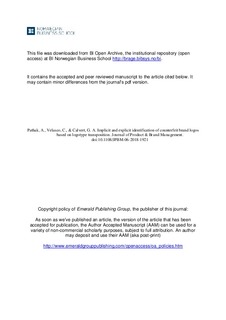| dc.contributor.author | Pathak, Abhishek | |
| dc.contributor.author | Velasco, Carlos | |
| dc.contributor.author | Calvert, Gemma | |
| dc.date.accessioned | 2019-07-01T12:07:24Z | |
| dc.date.available | 2019-07-01T12:07:24Z | |
| dc.date.created | 2019-03-01T19:45:28Z | |
| dc.date.issued | 2019 | |
| dc.identifier.citation | Journal of Product & Brand Management. 2019. | nb_NO |
| dc.identifier.issn | 1061-0421 | |
| dc.identifier.uri | http://hdl.handle.net/11250/2603044 | |
| dc.description.abstract | Purpose
With trade amounting to more than US$400bn, counterfeiting is already affecting many successful brands. Often, consumers are deceived into buying fake products due to the visual similarity between fake and original brand logos. This paper aims to explore the varying forms of fraudulent imitation of original brand logotypes (operationalized at the level of logotype transposition), which can aid in the detection of a counterfeit brand.
Design/methodology/approach
Across two studies, this research tested how well consumers can differentiate counterfeit from original logos of well-known brands both explicitly and implicitly. Seven popular brand logos were altered to create different levels of visual dissimilarity and participants were required to discriminate the logos as fake or genuine.
Findings
Results demonstrate that although consumers can explicitly discriminate fake logos with a high degree of accuracy, the same is not true under conditions in which logos are presented very briefly (tapping participants’ implicit or automatic logo recognition capabilities), except when the first and last letters of the logotype are substituted.
Originality/value
A large body of research on counterfeit trade focuses on the individual or cross-cultural differences behind the prevalence of counterfeit trade. There is limited research exploring the ability of a consumer to correctly identify a fake logo, based on its varying similarity with the original logotype; this paper addresses this gap. Given that many of the purchase decisions are often made automatically, identifying key implicit differentiators that can help a consumer recognize a fake logo should be informative to both practitioners and academics. | nb_NO |
| dc.language.iso | eng | nb_NO |
| dc.publisher | Emerald | nb_NO |
| dc.title | Implicit and Explicit Identification of Counterfeit Brand Logos based on Logotype Transposition | nb_NO |
| dc.type | Journal article | nb_NO |
| dc.type | Peer reviewed | nb_NO |
| dc.description.version | submittedVersion | nb_NO |
| dc.source.journal | Journal of Product & Brand Management | nb_NO |
| dc.identifier.doi | 10.1108/JPBM-06-2018-1921 | |
| dc.identifier.cristin | 1681831 | |
| cristin.unitcode | 158,11,0,0 | |
| cristin.unitname | Institutt for markedsføring | |
| cristin.ispublished | false | |
| cristin.fulltext | preprint | |
| cristin.qualitycode | 1 | |
